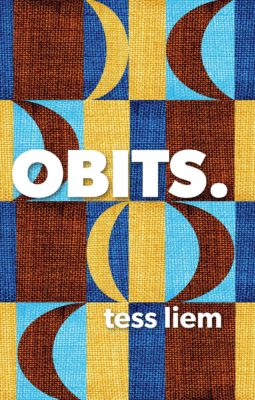In Tess Liem’s Obits., we make our way with the poet through the challenging process of mourning as she reflects on her own mortality. Attentive and introspective, these poems draw from contemporary events, psychoanalysis, mythology, television, feminist writing, and other sources in order to ponder death in all its intimacy.
Obits. stems from Liem’s MA thesis, a project composed of a series of elegies for women. The intention, Liem shares, was to write about as many historical and fictional women as possible. The death of her aunt, however, complicated these initial parameters. “I became overwhelmed with choice,” Liem says. “Whom should I elegize and Who am I to choose? I saw these questions as significant ethical and philosophical questions to consider when attempting to honour, mourn, and memorialize people in poetry. […] I realized I wanted to write about the absence left by a missing or unwritten elegy, or obituary, rather than just fill in the gap.”

Obits.
Tess Liem
Coach House Books
$19.95
paper
88pp
9781552453766
Lyrically sensitive and nuanced, Obits. confronts the difficulties of expressing loss in language, all the while questioning formal classifications. Liem’s struggle to work within
the confines of the obituary impels her to offer a number of other possible definitions for the form, such as “a story we have to tell ourselves,” “an arithmetic,” and “an opportunity.” But what is the role of the obituary? More importantly, what are its necessary limits and necessary failures? A published obituary is, in short, a death notice; but what happens when the pertinent circumstances are unknown to the living? This question has socio-political and racial underpinnings, which Liem elucidates in her opening poem, “Dead theories”:
I write names of missing & murdered women in a notebook.
I set up alerts.
I add up.
[…]
Maybe
if blonde & thin with straight teeth, those dead are less anonymous.
The speaker grieves for the remainder and remarks on the collapse of the obituary when the form cannot correlate to those whose lives are not written down, or whose deaths cannot be made public. By punning on the word “count,” the poet suggests how the obituary reckons a life’s value:
I may appear melancholic
When the object of my mourning is missing
When no obit. is printed
When a body an addend to a sum a number on a screen
When no one agrees on the number
[…]
When some lives count & others are counted
Even if the object is missing, what Obits. does make possible is ensuring that the reader takes notice of the lack. As Liem elaborates, “Loss is formalized in many ways: rituals, statues, poems, songs, etc. But the relation between those things and the lost thing I suppose highlights the impossibility of ever really restoring a lost object.”
An obituary is collected, stored, and can be accessed at will. This particular mode of engagement is not lost on the speaker who asks, “Did you know you can subscribe to
news / from Obitsarchive.com?”. The collection takes on the role of the archive as it, too, becomes a melancholic haven for accessing loss. Liem composes eleven variations of a poem, each entitled “Obit.” These poems circle restlessly around loss, whether loss in translation, cultural loss, or loss of self.
The orbit of the poet also encompasses the metro: surrounded by passengers dressed in drab colours, the chthonic rush hour is depicted by Liem as “a daily funeral.” The metro, an urban underworld, is the perfect analogy for perpetual mourning and, indeed, Liem reveals that she came across this conceit by accident while commuting to school. “I wanted to scrutinize the sameness of each day,” says Liem. “This analogy became a way of expressing how the numbness of persistent depression wavers if you look up and read the news and how this wavering itself can also become a routine and a rut. When you are commuting you encounter people, weather reports, current events, advertisements, homelessness, inaccessibility (escalators are often off, so few stations have elevators!) […] to me everything happens on the metro platform.”
The circuitous routes of the metro encourage these recursive processes: the speaker commutes daily and again performs her desolation as she circles back again and again to “Obit.” There is, in short, no relief. The metro is where various tensions in the book reach their highest intensity – whether between self and other, division and wholeness, immeasurable grief and the measured word, private and public, and confinement and distance. In a variation of “Obit.,” Liem writes:
I am allowed distance I am a loud distance
Bodies too close together are loud too
[…]
I’m tired of being touched
by everyone I’m tired of death
On the metro we keep to ourselves
I read strangers’ texts
[…]
Fold our arms against our ribs
We haven’t a physical distance between us
While the speaker resists the physical proximity of others, most moving in this collection is her awareness of the body’s capacity to make meaningful connections. It is not only the daily loss of bodies (“That number / revised, rises”) that preoccupies the poet, but how loss affects the living body – the remaining body that mourns. The death of her “last distant aunt” in Indonesia prompts questions about Liem’s own identity, the familial body serving as a personal archive housing a culture, language, and history that are remote (at best, fragmented) for the poet. And yet the reader is not lost in mourning. Liem, while acknowledging the risk of failure in her elegiac project, manages to locate recuperative moments in this world. Her poem, “Ibu, saudara, isteri,” for example, plays with her aunt’s name, “Hoei,” pronounced oui. The name of the deceased becomes a homonym for affirmation (“oui”) as well as community (“we”). As Liem writes elsewhere, “I want praise, not grief. / I want this poem to be an affirmation.”
Liem’s stirring debut attempts to measure that which is immeasurable as she navigates the dark orbit of language and finitude. Her voice emerges honestly and intimately, offering light for us to see ahead. mRb







0 Comments